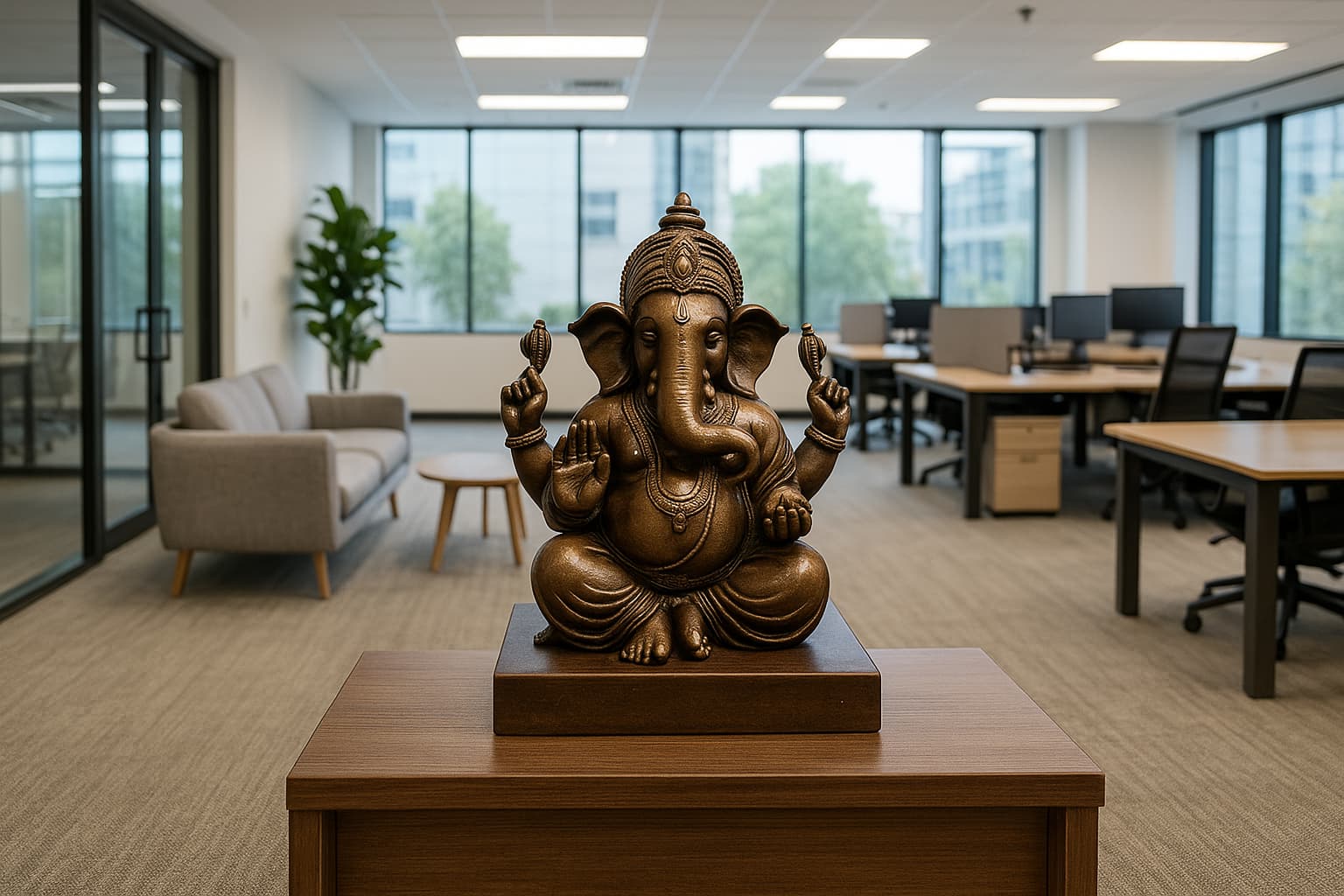Ganesha temple dress code is something many devotees wonder about — especially when planning to visit a temple for darshan. It’s not just about personal choice; what you wear reflects your respect for the sacred space. While some Ganesha temples follow a relaxed approach, others—especially traditional or village temples—expect modest, Indian-style attire. This simple guide helps you understand what to wear, what to avoid, and how to dress appropriately, no matter where your temple visit takes you.
👕 Why Does Dress Code Matter at Ganesha Temples?
Ganesha temple dress code isn’t just about rules — it’s about showing respect to the deity and the spiritual space you’re entering. In Hindu belief, Lord Ganesha is the one who removes obstacles and blesses new beginnings, so visiting his temple should be done with humility in both mind and appearance. Wearing clean, simple, and traditional clothes helps create a peaceful and respectful environment, not just for you but for everyone around. Whether you’re stepping into a famous shrine or a small village temple, dressing modestly shows that you’re entering with devotion, not distraction.
🧑🤝🧑 General Dress Code for Devotees
When it comes to following the Ganesha temple dress code, the rule is simple — wear clothes that are modest, clean, and respectful. Whether you’re going to a big temple in the city or a small village shrine, traditional attire is always a safe and respectful choice.
👨 For Men:
✔️ Dhoti with angavastram (most traditional and preferred)
✔️ Kurta-pajama or formal shirt with trousers (accepted in urban temples)
❌ Avoid: Shorts, sleeveless vests, track pants, or ripped jeans — these are considered too casual or inappropriate for temple premises.
👩 For Women:
✔️ Saree, salwar kameez, or long kurti with leggings are ideal.
✔️ Carrying a dupatta or shawl adds modesty and is highly recommended, especially in traditional temples.
❌ Avoid: Sleeveless tops, short skirts, transparent clothes, or tight-fitting western wear like jeans with rips — these are best kept for casual outings, not darshan.
👦👧 For Children:
Simple, comfortable ethnic clothes like kurtas or frocks are good.
Avoid clothes with bold slogans or cartoon prints in spiritual spaces.
🪔 Tip: Wearing light-colored, cotton-based clothing is comfortable and looks clean — especially during festivals and summer temple visits.
🏛️ Popular Ganesha Temples & Their Dress Norms
While the Ganesha temple dress code can vary slightly from place to place, many well-known temples across India follow similar expectations: dress modestly, avoid revealing or casual clothes, and wear something respectful for darshan.
Here’s a quick look at the dress expectations in some of the most visited Ganesha temples:
🛕 1. Siddhivinayak Temple (Mumbai)
🔸 One of the most visited Ganesha temples in India.
🔹 No official dress code, but modest Indian attire is preferred.
❌ Avoid shorts, sleeveless tops, or tight western wear.
✅ Simple kurta-pajama or salwar kameez is ideal.
🛕 2. Dodda Ganapathi Temple (Bengaluru)
🔸 Popular temple in Karnataka’s capital city.
🔹 No strict enforcement, but devotees usually come in traditional clothes.
❌ Avoid flashy, party-style clothes or deep-neck outfits.
✅ A saree, kurti, or formal wear suits the atmosphere.
🛕 3. Idagunji Ganapathi Temple (Uttara Kannada)
🔸 A famous coastal temple with clear dress guidelines.
🔹 Men should wear dhoti, pyjama, or formal pants with a shirt.
🔹 Women should wear saree, salwar suit, or half-saree.
❌ Western outfits like jeans, t-shirts, or sleeveless tops are not allowed.
🛕 4. Pazhavangadi Ganapathy Temple (Kerala)
🔸 Known for its traditional Kerala customs.
🔹 Strictest dress code among major temples.
🔹 Men must wear mundu (no shirts or pants allowed inside sanctum).
🔹 Women must wear saree or long traditional attire.
❌ Pants, jeans, or western wear are not permitted.
🛕 5. Manakula Vinayagar Temple (Pondicherry)
🔸 A spiritual and tourist-friendly temple.
🔹 Dress modestly; shoulders and knees should be covered.
✅ Long kurtas, dupattas, and sarees are good choices.
❌ Avoid short skirts, sleeveless tops, or gym-style outfits.
🧳 What to Wear (Recommended Items)
| Item | Who Should Wear | Notes |
|---|---|---|
| Dhoti + Angavastram | Men | Most respectful in traditional temples |
| Saree | Women | Ideal for all temples |
| Salwar Kameez | Women | Acceptable everywhere |
| Kurta-Pajama | Men | Urban-friendly |
| Full-Length Skirts | Women | Good alternative for saree |
| Kids Ethnic Wear | Boys/Girls | Comfortable and cute |
❌ What to Avoid
| Item | Reason |
|---|---|
| Shorts (Men & Women) | Too casual and considered disrespectful in most temples |
| Sleeveless Shirts or Blouses | Lack upper-body coverage; not modest in sacred places |
| Ripped Jeans / Transparent Clothing | Seen as informal and inappropriate for darshan |
| Crop Tops / Miniskirts / Skin-tight Outfits | Considered too revealing for temple visits |
| Caps / Hats / Sunglasses | Remove when entering temple interiors as a mark of respect |
| Footwear | Must be removed before entering temple premises |
🙏 Cultural Tips for Visiting Ganesha Temples
- 🚿 Bathe and wear fresh clothes before visiting
- 👣 Remove footwear outside the temple
- 🧴 Avoid strong perfumes or makeup to maintain sanctity
- 📸 Refrain from taking photos inside the sanctum unless permitted
- 🤫 Maintain silence or chant softly during darshan
📍 If You’re Visiting Karnataka Temples…
Temples across Karnataka — such as Anegudde, Idagunji, Gokarna Mahaganapathi, and Basavanagudi Dodda Ganapathi — deeply value traditional attire. While not all temples have written dress codes, the cultural expectation is clear: visitors are encouraged to wear respectful and modest clothing. In rural and village temples especially, blending in with local customs shows reverence and understanding. Wearing a simple cotton saree, salwar kameez, kurta, or dhoti not only keeps you comfortable during darshan but also aligns with the spiritual atmosphere of these sacred places.
Following the Ganesha temple dress code isn’t just about tradition — it’s a simple way to show devotion and humility when entering a sacred space. Whether you’re visiting a famous temple in the city or a small shrine in a village, wearing modest and respectful attire creates the right mindset for prayer. By choosing traditional, comfortable clothing, you not only honor the temple customs but also deepen your own spiritual experience. Let your outfit reflect the same respect you carry in your heart for Lord Ganesha.

